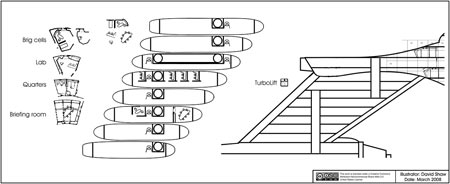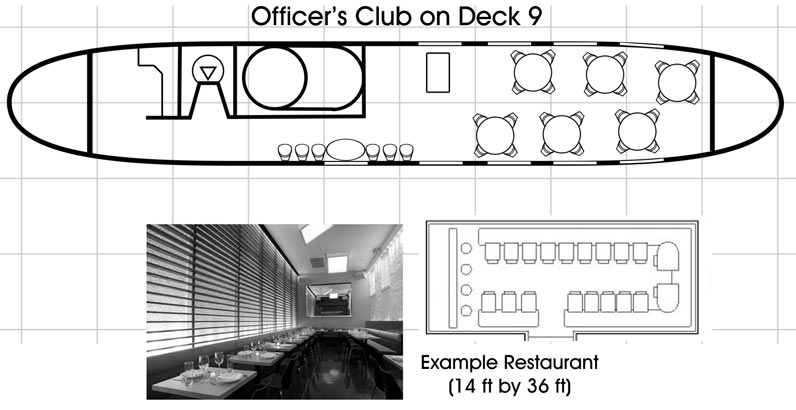Now, I was just posting in the Art forum where another poster was arguing against the changes believed made on the Enterprise in the upcoming Trek film. One of the arguments was regarding the 'fins' that are located about where the 'intercoolers' on the nacelles are on the original Constitution class as we know it. Now, in space, the ship is in as near a vacuum as exists. This makes losing heat very difficult, as you are stuck with only radiative cooling. In the thread I made the argument that the fins, which in fact do have a fairly large amount of surface area, make for good, perhaps excellent radiative surfaces.
Now, when you look at the nacelle pylons and interconnecting dorsal of the original Enterprise, they each have at least half as much surface area as the nacelles and secondary hull respectively, while having very little practically usable room inside them. Is it possible that perhaps these areas may have been designed in at least partially as radiator elements?
Hi Nightfall...
The trick about radiator elements is that you need to have the absolute minimum material between the exterior surface of the radiating element and the cooling fluid being routed underneath it. So, putting tubing up next to the inside of the surface of the hull isn't going to give you as effective of a cooling solution as having that tubing directly exposed to space.
This doesn't invalidate the idea of having cooling plumbing arranged right against the inside surface of the hull skin, of course... while slightly less effective, it would allow the use of a lot more surface area. However, if that's the case... you again lose any reason for having the FINS. You could do the same thing just as effectively, and honestly (if you get into the physics of it) MORE effectively, by simply leaving the nacelle completely cylindrical. There's no mechanical advantage to even partially "shading" the projected area in that fashion, is there?
Once again, you're back to the whole bit about the fins being there for appearance's sake rather than for mechanical purposes. Which is what bugs me about them.
NOW... to your point about using the neck and pylons as radiators... I agree wholeheartedly, and that also was part of the concept, both for the TOS ship and the TMP ship. Not the neck, so much, but DEFINITELY the engine nacelle support pylons.
In TOS, we see the following elements which appear to be radiator-type cooling devices:
1) The little boxes on either side at the aft end of the nacelles.
2) The intercooler loops at 45 degrees from C/L on the nacelles.
3) The primary cooler loop (later dubbed the "control reactor loop" by FJ) on the inboard surface of the nacelles.
4) The grillwork on the inside surfaces of the pylons... which happen to be reasonably well-placed as radiator surface, but which really should have been duplicated on the exterior surfaces as well!
We also see some grillwork on the inside surface of the nacelle, but that's so poorly set up for cooling purposes that it must have some other function, I think.
Now, for TMP:
We have a similar grill to what was on the TOS ship, but lit, on the inboard surface. NOT a "radiator," again, IMHO. But we DO have the following:
1) Radiator surfaces on the exterior faces of the nacelles.
2) Radiator surfaces on the interior and exterior faces of the pylons (but this time, the larger area is on the OUTSIDE, which makes more sense!)
We also have some "fins" on the engine nacelles... which really make no sense as far as I'm concerned. Those features, and all the other "art deco styling"... could go from that nacelle design and I'd certainly never miss it. As far as I'm concerned, "fins" only have a reason to exist if they're on vehicles designed for atmospheric operation, and then they must be designed to meet certain very specific criteria (primarily, they must be located to the aft, in order to give the ship a forward-facing stable orientation, and must be only large enough to ensure that stability!)
SO... I happen to agree that the pylons are the most logical point for the cooling system for the ship's basic systems to be located. Additional "point-functionality" loops would be created immediately adjacent to whatever hardware they were intended to operate with.
I could live, easily, with the total removal of those exterior loops (especially since that could be taken to imply that they were added later as a retrofit to give the ship a small improvement in performance without totally rebuilding her!) I just can't accept "purely decorative" features replacing these functional ones.
Make sense?




 Or just when the ship's in drydock, or visiting that big space carwash from TNG "Starship Mine".
Or just when the ship's in drydock, or visiting that big space carwash from TNG "Starship Mine".